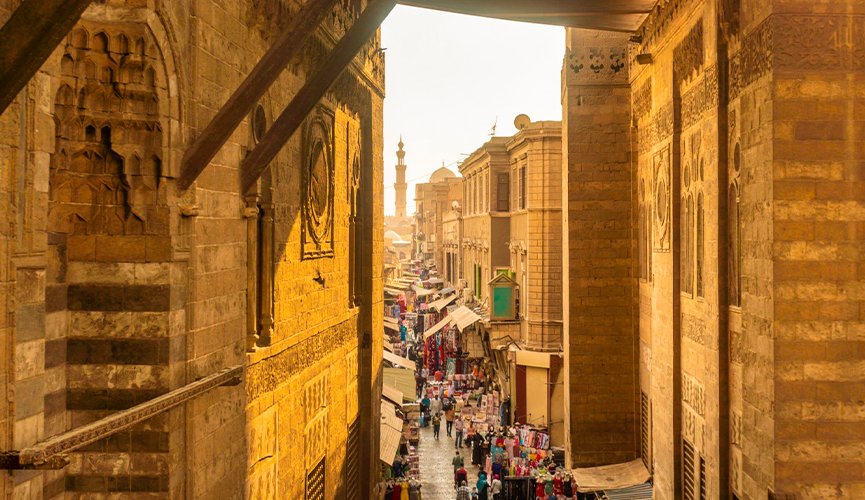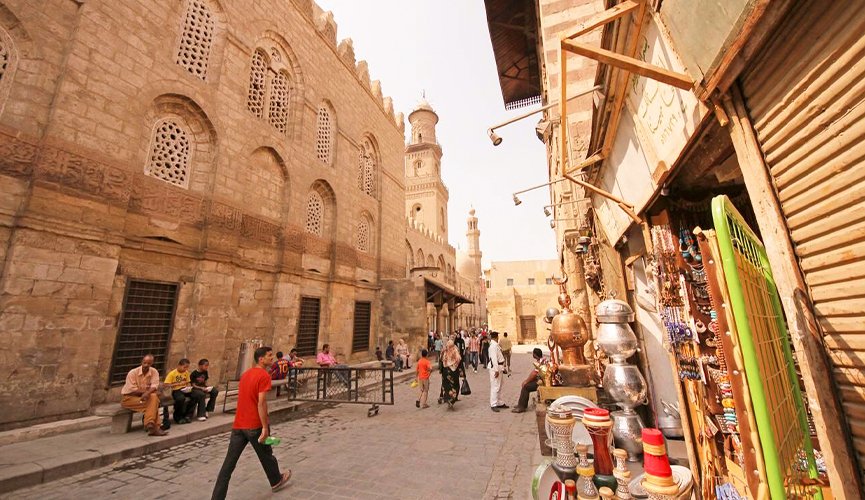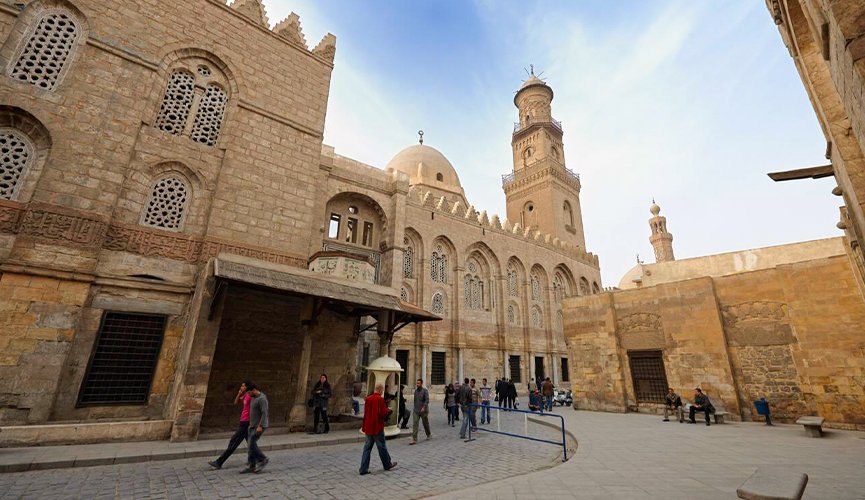Al Muizz Street, also called Al-Muizz li-Din Allah Street, is an old street in the center of Cairo, Egypt. It is also known as Al-Muizz li-Din Allah Street. It is about a kilometer long and goes through a lively area in Islamic Cairo. The street was built during the Fatimid rule in the 10th century, essential to Egyptian history and society.
Al Muizz Street is known for its beautiful buildings and rich cultural history. It is often called an “open-air museum” because the street is lined with many well-preserved Islamic houses and sites from the Middle Ages. Here are a few of the main things that make Al Muizz Street stand out:
Historical Significance of Al Muizz Street

Exploring the rich history of Muizz Street
Al Muizz Street has a long and exciting past lasting over a thousand years. It was first planned in the 10th century, when the Fatimid kingdom, which made Cairo its home, was in power. The street was first named after the Fatimid ruler Al-Muizz li-Din Allah, who was very important to the city’s growth.
The ancient Islamic architecture and landmarks
Al Muizz Street is famous for having some of the best examples of Islamic buildings from different times. Walking down the street, people can admire the fantastic facilities showing how architectural styles have changed.
- Fatimid Architecture: The Fatimid time significantly affected Muizz Street’s architecture. One famous example is the Al-Azhar Mosque, built in 970 AD as a place to learn and is now one of the world’s most excellent colleges. The mosque’s beautiful minarets and elaborate designs show how far art had come at the time.
- Ayyubid and Mamluk architecture: After the Fatimid empire fell, the Ayyubid and Mamluk regimes took over Cairo. On Muizz Street, buildings like the Mosque of Sultan Qalaun, built in the 1300s, show how good they were at the facility. It stands out on the street because of its tall steeple.
- Ottoman influence: During the time of the Ottomans, more changes and improvements were made to the buildings on Muizz Street. The Mosque of Sultan al-Ghuri, built in the 1600s, is the most famous example. Its domes and ornate walls, typical of Ottoman architecture, show how styles have changed.
Why Muizz Street was important during the Fatimid era
Al Muizz Street was important during the Fatimid period because it was the heart of government and religious power. Cairo became an important city under the Fatimid caliphs, and Al Muizz Street became the center of their kingdom.
- The seat of the Caliphate: The royal house complex and administrative center of the Fatimid caliphs were on Al Muizz Street, which was the seat of the caliphate. It held government buildings, courts, and places for ceremonies, which showed how powerful and influential the line was.
- Religious and Educational Center: The street became a hub for places of worship and schools. The Fatimids set up the Al-Azhar Mosque, an essential part of spreading information and creating Islamic learning. It brought experts from all over the Islamic world to Cairo, making it the educational center of the Islamic world.
- Urban Planning and Architectural Vision: Al Muizz Street shows how the Fatimids planned cities and built buildings. The street was carefully planned, with wide streets, fancy buildings, and large parks. This set of buildings was meant to show how powerful and beautiful the kingdom was.
During the Fatimid era, Al Muizz Street was important for more than just its architecture and administration. It represents the goals and accomplishments of a family that changed the religious and cultural scene of Cairo and left a lasting memory for future generations to enjoy.
Exploring Al Muizz Street Today
How Al Muizz Street has changed since the present day
Al Muizz Street has changed over the years, adapting to the changing ways of life in Cairo while keeping its historical feel. People have worked to fix up and improve the street so that its culture and building history stays the same.
- Restoration Projects: Al Muizz Street has had a lot of work done to keep its building gems in good shape. These projects aim to fix up and restore historic buildings, bringing back their original beauty and ensuring they are still safe.
- Pedestrianization and conservation: Parts of Al Muizz Street have been made pedestrian-only, making it easier for people to get around on foot. This way, people can look around the street at their own pace, enjoying the building features and soaking up the cultural atmosphere.
The busy shops and markets
Al Muizz Street is famous for its busy markets and old-fashioned shops, which add to its lively mood and cultural importance. When people visit these shops, they get a glimpse of the rich history of commerce in Cairo.
- Traditional Crafts and Artisans: The street is lined with shops and carts that sell conventional crafts like jewelry, fabrics, pottery, metals, and woodwork. Skilled craftspeople still do their work, keeping old methods alive and passing them down from generation to generation.
- Spice and Perfume Market: This street has a busy spice and perfume market. It has a wide range of fragrant spices, herbs, and perfumes. Visitors can let their senses run wild and enjoy the bright colors and pleasant smells.
- Authentic Local Experience: The markets on Al Muizz Street give tourists a real taste of being local. They can talk to sellers, haggle for unique items, and see how busy Cairo’s business scene is.
Why Al Muizz Street has become such a popular place for tourists
Al Muizz Street has become a popular place for tourists to visit. People come worldwide to learn about its history, culture, and architecture.
- UNESCO World Heritage Site: The fact that Al Muizz Street is now a UNESCO World Heritage Site has made it much more well-known and appealing to tourists. This honor shows how vital the street is to everyone and ensures it will be around for future generations.
- Architectural and Cultural Tours: Many tour companies offer Al Muizz Street guided tours. The guides tell tourists exciting stories about the street’s history, architecture, and cultural importance. Tourists can learn more about the history of the buildings and sites on these trips.
- Cultural Events and Festivals: Al Muizz Street has become a place for many cultural events, festivals, and shows. These events honor Cairo’s history and allow tourists to realistically see traditional music, dance, and arts and crafts.
- Central Location: Al Muizz Street is in the middle of Islamic Cairo, which makes it easy for people staying in nearby hotels and other places to visit to get there. Its closeness to other exciting sites, like the Egyptian Museum and the Citadel of Saladin, makes it a must-see spot.
The changes to Al Muizz Street, the busy markets, and the rising number of tourists have given the area a new lease on life and renewed interest in Cairo’s rich history and cultural heritage. Today, it is a reminder of the city’s rich history and gives tourists a whole experience that connects the old and the new.
The Challenges of Preserving Al Muizz Street’s History

The work done to protect Al Muizz Street’s building history
Al Muizz Street’s building history must be kept safe through the hard work of many groups, including the government, protection groups, and the local community.
- Restoration and Conservation: The ancient houses along Al Muizz Street have been repaired and kept in good shape through several restoration projects. These projects require careful work to keep the original building features and materials.
- Documentation and study: Keeping records of Al Muizz Street’s architectural history and doing a historical study are two essential ways to learn about the buildings there. This knowledge helps restorers know what to do and ensures accurate work.
- Zoning and Protective Measures: Setting up the proper zoning rules and putting protective measures in place ensure that the surrounding areas and new projects fit in with Al Muizz Street’s history as little as possible.
The problems that have to be solved to keep Muizz Street’s originality
It can be hard to keep Al Muizz Street’s original feel facing current issues like urban growth and tourists.
- Pressure from cities and growth: As Cairo becomes more crowded, AlMuizz Street is in danger of destruction. Increased population growth and urban development around the street can cause ancient buildings to be damaged, changed, or even torn down.
- Impact of Tourism: Tourism is vital for local income, but many tourists can have good and bad effects on Muizz Street’s originality. It can be hard to meet the wants of tourists without hurting the local culture and history.
- Conservation Funding: Getting enough money for projects that restore, maintain, or save something can be challenging. Not having enough cash can make protecting Al Muizz Street’s architectural history harder.
The importance of balancing historic preservation with modern development
For Al Muizz Street’s long-term success, it is essential to balance maintaining its historical past and adapting to current changes.
- Management of Sustainable Tourism: Using sustainable tourism methods helps protect Al Muizz Street’s history while giving tourists a good time. Managing the number of visitors, encouraging responsible tourism, and reducing harmful effects are all essential things to consider.
- Community Engagement: Getting the people in the area involved in protection projects gives them a feeling of ownership and pride. Their participation in decision-making and protection efforts ensures that Al Muizz Street stays a live part of the community’s history.
- Adaptive Reuse and Economic Viability: Finding creative ways to reuse ancient buildings can make Muizz Street more economically viable while keeping its original character. Putting cultural places, boutique hotels, or schools for artists in old buildings can give a street new life.
- Education and Awareness: Teaching locals and tourists about Al Muizz Street’s history and culture and making them aware of its importance helps them respect and value its history. This makes people feel like they have a shared duty to protect it.
Al Muizz Street’s past needs to be kept alive in a way that considers urban growth, the effects of tourists, and limited funds. By using environmentally friendly methods, involving the community, and creating creative solutions, Al Muizz Street can continue to be a lively historical place while living in harmony with new growth.
The Future of Al Muizz Street
A. The future growth and progress possibilities
Al Muizz Street has a lot of room to grow and change in the future, both as a place to visit for history and as a lively cultural hub.
- Economic growth: Al Muizz Street can become a significant economic driver for the area. With careful planning and funding, it can bring in more tourists, create jobs, and help local businesses.
- Cultural revival: Al Muizz Street’s cultural revival can be helped by attempts to keep repairing and protecting its architectural history. This can be done by putting on cultural events, concerts, and gatherings that show off the history and customs of the street.
- Urban Regeneration: Al Muizz Street can help bring about urban renewal in the neighborhoods around it. Bringing the street back to life can lead to repairing nearby buildings and improving public areas, which is good for the whole community.
Why it’s essential to keep tourism sustainable
Sustainable tourism is essential for Al Muizz Street’s long-term growth and for keeping its history alive.
- Responsible Tourism Practices: Focusing on responsible tourism practices ensures that tourists interact with the street politely and reasonably for the environment. This means informing people about cultural sensitivity, reducing trash, and helping local businesses and artists.
- Conservation of Al Muizz Street’s History: Conservation of Muizz Street’s history should be a top priority for sustainable tourism. This means balancing how much people can do and how well historical buildings, objects, and cultural customs are kept.
- Cultural Exchange: Sustainable tourism makes it possible for tourists and locals to share their cultures helpfully. This exchange helps people understand, accept, and appreciate each other’s cultures, making visitors’ and locals’ trips more enjoyable.

